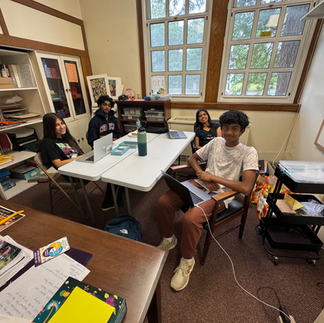From Idea to Impact: What a 6-Week Internship Taught Students About Marketing — and Themselves
- Games For Seva
- Aug 13
- 4 min read
Updated: Sep 10
3 Games. 3 Teams. 3 Journeys from Idea to Impact.
Powered by memes, moodboards, and midnight brainstorms.Every game began with a question. Every team ended with a story.
FOLLOW US ON INSTAGRAM FOR LIVE UPDATES

Not Just an Internship — A Creative Journey
Most people think of marketing as ads, slogans, and sales. But for a group of high school and college students this summer, it became something much deeper: a way to tell stories, build confidence, and learn by creating.
Over the course of five weeks, these students stepped into the fast-paced world of startup-style marketing. They weren’t just interns — they were brand builders, content creators, and campaign strategists. What set this internship apart?
Real creative freedom
Real launches and deadlines
Real reflection and feedback
And real growth
This is the story of what happened — and what they built.

Week 1: Finding the Brand’s DNA
“Marketing starts with meaning — not just logos.”
The program began with storytelling, team-building, and a dive into the heart of brand identity. Before designing a single post, students explored the "why" behind the brand they were building.
They used tools like Canva to design moodboards that expressed their team’s values, personality, and message. They asked important questions:
What does our brand stand for?
How do we want people to feel?
What story are we really telling?
Their first major insight: A good brand isn’t built on visuals alone — it’s built on values.
Week 2: Building the MVP (Minimum Viable Post)
“Every post needs a purpose.”
In week two, ideas turned into visuals. Students dove into the essentials of digital marketing — learning how to craft calls-to-action (CTAs), shape a brand voice, and use storytelling to communicate clearly.
Each student created a mini content pack: a carousel, a meme, and an explainer post. Through collaborative feedback rounds, they learned how to take critique constructively — and improve their designs with intention.
Week 3: Testing What Works
“Good marketing listens before it speaks.”
With a batch of draft content in hand, students shifted into testing mode. They ran A/B tests on headlines, post designs, and captions — gathering real-time feedback from mentors and peers.
A highlight of the week? A fast-paced “Shark Tank” session where teams pitched their content and received unfiltered feedback. Some ideas flopped. Others unexpectedly took off. The learning came from both.
Week 4: Going Public
“Creativity gets real when it meets the audience.”
Week four was launch week. The student teams published their content campaigns across social channels, tracked engagement, and adjusted their strategy in real time. Each team member took on a role — from content lead to analytics manager.
This wasn’t a simulation. These posts went live to real audiences — and the response mattered.
[Insert: Campaign highlight video or screenshots of engagement]
Week 5: Wrapping It All Into Story
“Storytelling is strategy — and reflection makes it stick.”
In the final week, students stepped back to reflect. They delivered presentations, filmed video reflections, and wrote letters to next year’s interns. Each team created a playbook that documented their brand, process, lessons, and advice.
The focus wasn't just on marketing strategy — but on personal growth.
[Insert: 30-second video clip or reflection moment]
What They Took Away
Beyond learning the tools of digital marketing, students walked away with something more meaningful: a deeper understanding of themselves as creators, communicators, and collaborators.
Here’s what they discovered:
Creativity isn’t about perfection — it’s about momentum.
Teamwork means balancing ideas, feedback, and trust.
Confidence grows when you launch, learn, and repeat.
The Internship Portfolio: What They Built
This wasn’t a lecture-based internship — it was a production sprint. Here’s what each team shipped:
✅ 1 Brand Moodboard
✅ 1 Mini Content Campaign (with analytics)
✅ 1 Final Pitch Deck
✅ 1 Reflection Blog (this one!)
✅ 1 Team Playbook for the next cohort
📁 Final pitch decks from all teams –
The Concluding Capstone Event
Meet Davesh Shah - Chief Internship Architect

Davesh Shah is a global business leader with experience spanning high-growth startups, regulated markets, and banking. A graduate of the University of Pennsylvania, he is now at Stripe, helping some of the world’s largest companies modernize their payment systems and scale globally. His career has taken him across North America, Europe, and Asia, giving him a unique perspective on how innovation and cultural insight work together. Outside the office, Davesh mentors social enterprises in New York City and brings his training as a certified yoga and mindfulness instructor into leadership and community work.
Meet the panelists for the Capstone Event



Final Message: Keep Creating
To parents, mentors, and future interns:
This summer wasn’t just about learning what marketing is. It was about discovering what students are capable of when they’re trusted to lead, create, and reflect.
As one team wrote in their final journal:
“Marketing is more than ads. It’s about listening, testing, and telling stories that matter.”
Let’s keep making space for young creators to make — and learn by doing.
🔗 [Optional: Link to full video, team portfolios, or contact page]





































Comments